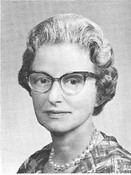|

1907 2006
Elizabeth Stein
NORMAL - Though Elizabeth Stein died just a year shy of her centennial birthday last May, Bloomington-Normal's longest-running toiler in the arts was active nearly to the end. Barry Blinderman, director of Illinois State University's University Galleries, recalls that "she kind of slowed down after 2002," due to some mounting health problems. Even so, in 2002, she would have been 95, an age at which most people aren't even still around to make the decision to slow down. Since Stein was a photographer who toted her own camera, that meant she wasn't sitting in her sunroom in her 80s and 90s, dabbling in a little paint to pass the time. "She always was down in the trenches," says Blinderman. "She would go around looking for subjects. When she was younger, she walked around Chicago and out in nature. When she became older, she had people drive her around, and if she saw something that struck her as fascinating, she would ask them to stop. If it was a construction site, she would ask the people there if she could walk around it." He adds, "It seemed impractical for this little old lady to get up close to view buildings that were demolished or being demolished" - one of her photographic obsessions - "with homeless people camping out around them." But then, no one ever said Elizabeth Stein was practical. "Most people wouldn't be interested in climbing around in dirt, but Elizabeth was adventurous; she couldn't pass anything by," says Blinderman. "She was a real character." For proof, Blinderman and the University Galleries are opening a memorial exhibit of Stein's work, "Elizabeth Stein (1907-2006): Photographs and Photo-Collages," which debuts Friday with a reception and remembrances from several of Stein's former students-turned artists (see accompanying story). The show features 40 images and collages representing Stein's various thematic photographic obsessions. They include the aforementioned demolition sites and heavy construction equipment, as well as ropes and knots, the play of light and shadow over eggs, nature scenes, rocks, window reflections, bell peppers, flower arrangements, circus clowns and more. The images span her key photographic tenure, which didn't begin in earnest until her retirement from a 25-year teaching career at Bloomington High School (1945-1971). The most recent images date to about four years before her death at 99. "Whenever I see a construction site," said Blinderman, who helped select the images with Stein's longtime friend, Mel Theobald, "I can't possibly look at it without thinking of her work. When she was doing things with, say, steam shovels, she was always able to find some sort of poetic view of it - as in a dinosaur with big teeth and claws." He continues, "This coincidence between something mechanical and something natural seemed to fit her other subject matters, a lot of them concerned with nature - bowls of eggs, arrangements of flowers, bell peppers. She would find a pattern in anything, say, an arrangement of chairs. She had a very keen eye and an incredible gift for composition, always seeing the abstract in everything she was doing." A 1936 graduate of Vassar College, Stein studied at the School of the Chicago Art Institute, where she earned her bachelor's degree in 1941 and her master's degree in 1955. In the first of her many philanthropic gestures over the decades, she created the Elizabeth Stein Scholarship Fund in 1961 at the Art Institute, which, according to an Institute spokesman at the time of her death, continues to benefit students to this day. Her teaching career began in Sioux Falls, S.D., followed by her 25-year tenure as art teacher at BHS. Among her hundreds of pupils over the years was the celebrated Chicago painter Elizabeth Murray. In a 1980 Pantagraph interview, Stein said, "One of my chief goals in teaching was to communicate to my students my appreciation of the visual world." As a photographer, "I photograph what hits me, what composes where beauty is, where light is. I try to be with my camera," she said in a 1974 interview. Blinderman was not one of Stein's BHS pupils. "But of the ones I've met, it seems she just changed many of their lives. I've heard so many stories of how perceptive and helpful she was," he says. As a photographer, Blinderman recalls with amusement how Stein would brings "bags full of slides" to the University Galleries to show him her latest work, always hoping for another show (she tallied three local exhibits in the '90s alone: a 1992 solo show at the McLean County Arts Center, as part of a 1994 Arts Center group show celebrating McLean County's female artists and, last of all, on the eve of her 90th birthday, another solo show at ISU.) "She was always so excited," he says. "She had quite a motor on her. Even when she got frail, her mind was so sharp. I never saw her blank out on a word; she remained very articulate and funny and spirited, with a very sharp sense of humor. And she could be critical, too. Very endearing." In the end, says Blinderman, Stein will be remembered on multiple counts. "I knew so few women of her age who were such steadfast and accomplished people. Some people play canasta and cards with the ladies. But she was out there all the time, always with a camera. She had a really good eye. She was also a very caring, extremely devoted teacher. And then there's her generosity." (Benefactors of her giving include, besides the Art Institute of Chicago, ISU's School of Art, the McLean County Arts Center, Miller Park Zoo and the Parklands Foundation at the Merwin Nature Preserve, where a trail is dedicated in her honor.)
|